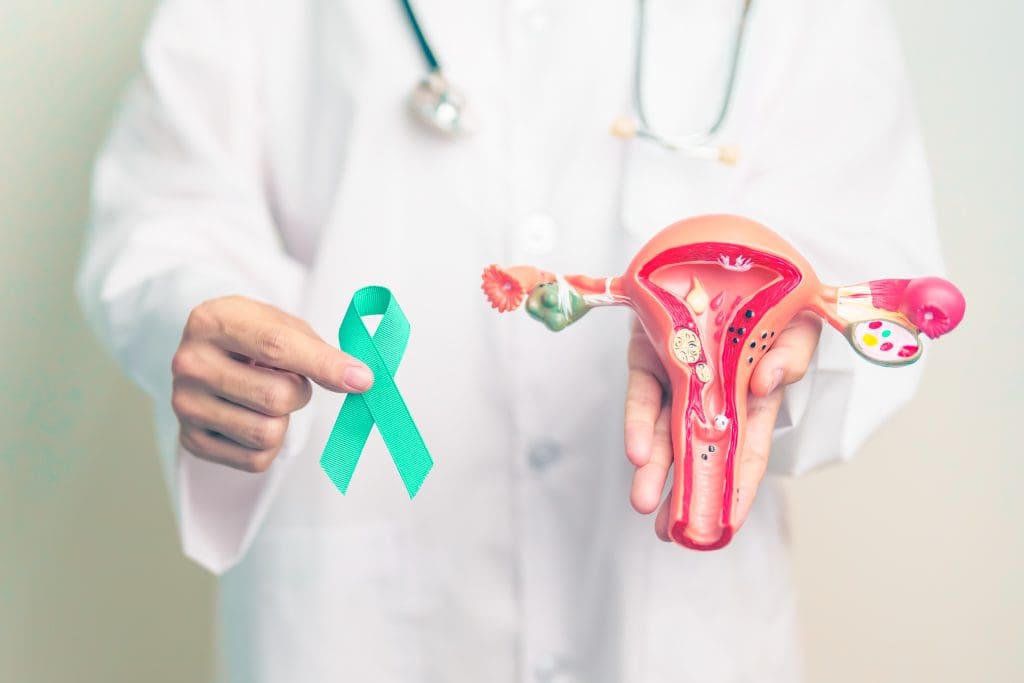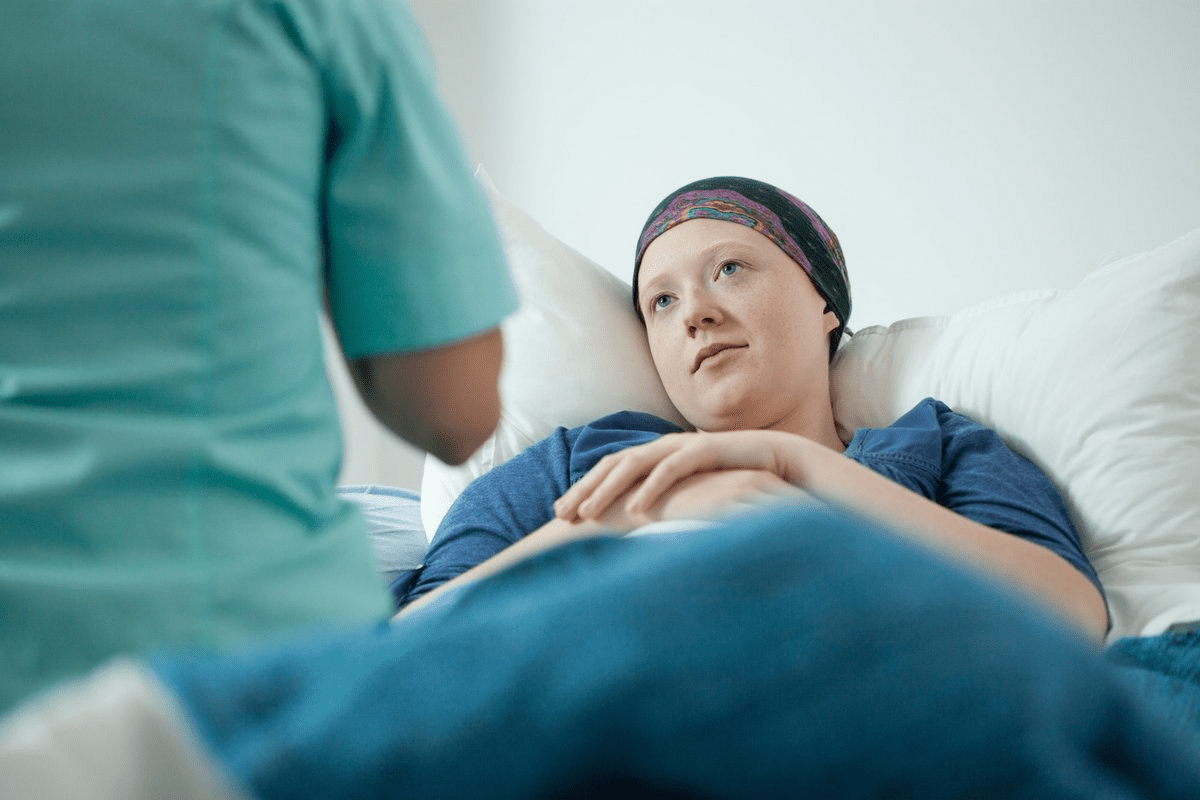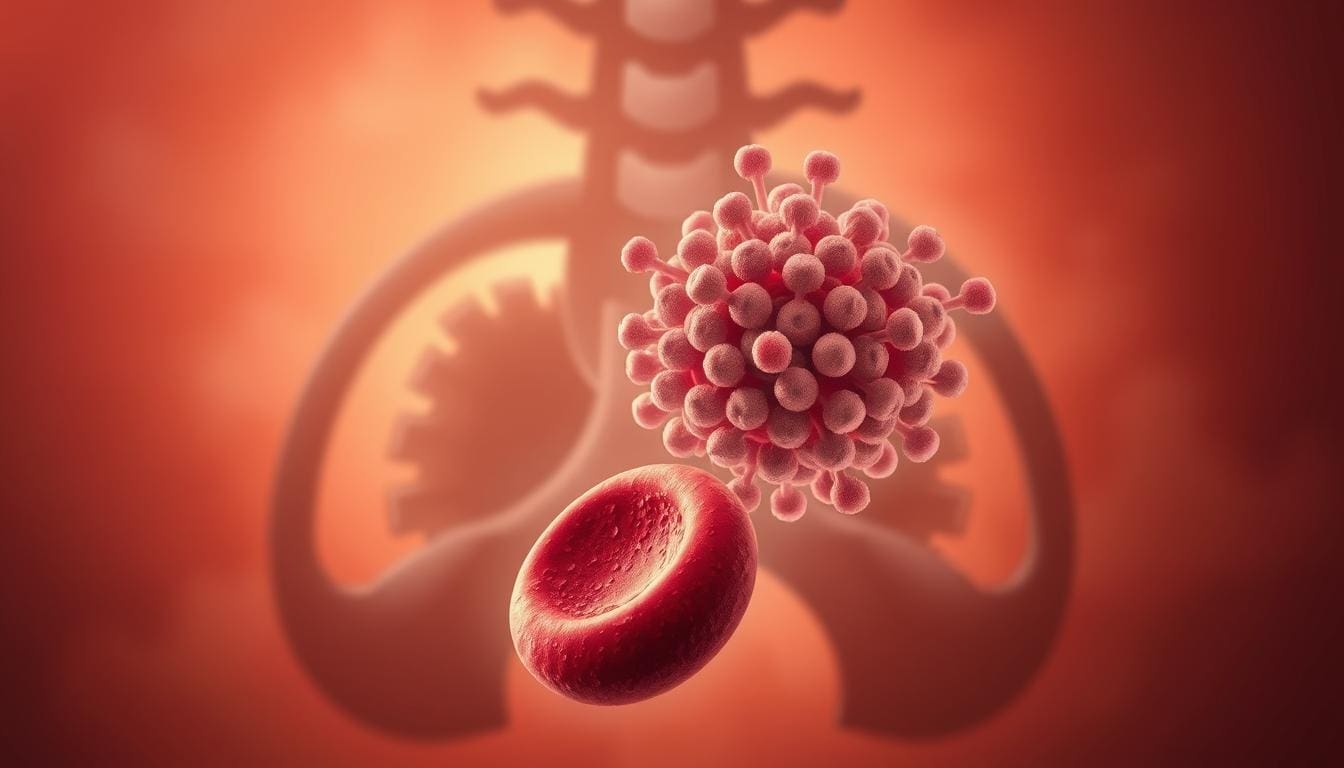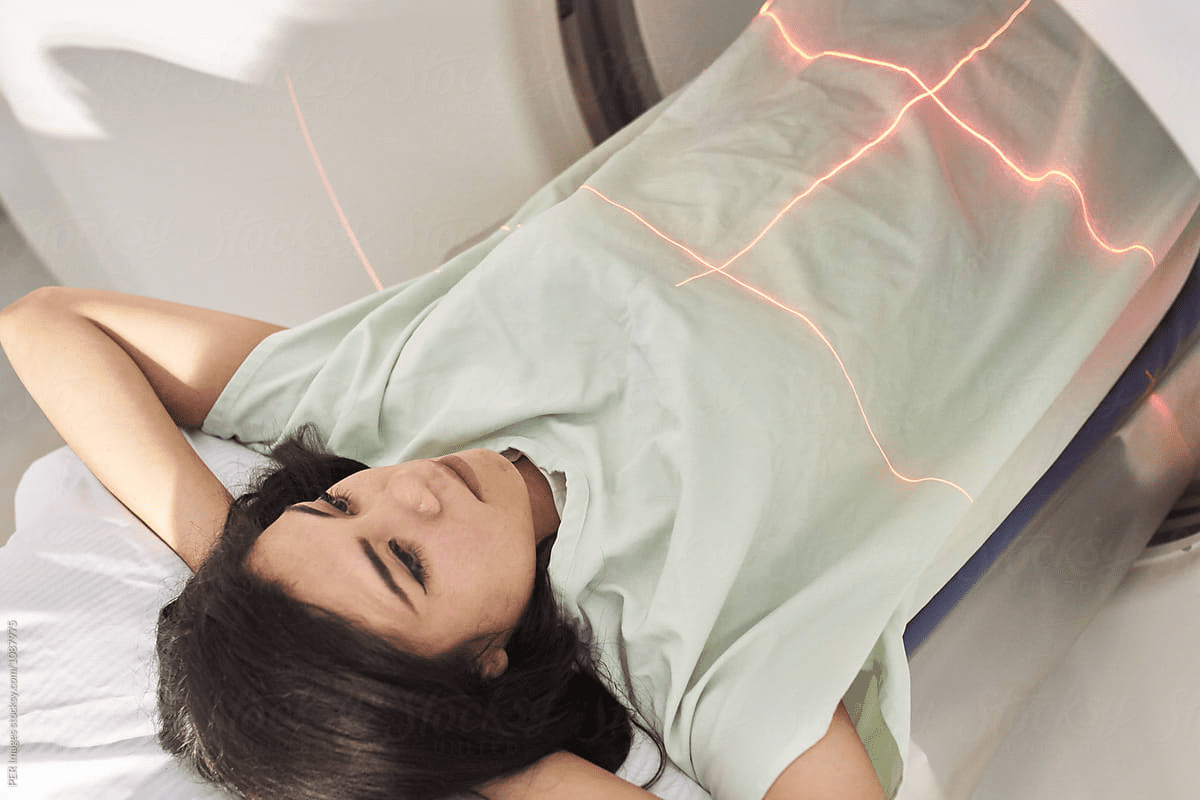Where is pain felt with ovarian cancer? Ovarian cancer is often called a “silent killer” because its symptoms are often mistaken for other less serious conditions. A survivor learned the importance of trusting their instincts after noticing unusual pain that led to medical consultation.
It’s vital to recognize the early signs of ovarian cancer to get medical help quickly. Pain is a common symptom, but it can show up in different places in the body. Knowing these symptoms can help people get medical help sooner.

Key Takeaways
- Ovarian cancer symptoms are often mistaken for other conditions.
- Trusting your instincts about unusual pain is important.
- Pain from ovarian cancer can be felt in various parts of the body.
- Early recognition of symptoms is key to timely diagnosis.
- Understanding the signs can lead to sooner medical intervention.
Understanding Ovarian Cancer and Its Prevalence
Knowing about ovarian cancer is key to catching it early and saving lives. It’s a big health issue that hits thousands of women around the world.
What is Ovarian Cancer?
Ovarian cancer starts in the ovaries, which are part of the female reproductive system. It often grows before symptoms show up, making it hard to catch early. There are different types, but most cases are epithelial ovarian cancer.
We don’t know what causes ovarian cancer, but some things increase the risk. These include genetic changes, family history of cancer, and age. Women over 50 are more likely to get it.
Statistics and Risk Factors
Ovarian cancer stats show why we need to be aware and catch it early. It’s the fifth leading cause of death from cancer in women in the U.S. The risk factors include:
- Genetic predispositions: Having mutations in the BRCA1 and BRCA2 genes raises the risk.
- Age: The risk goes up after 50.
- Family history: Having ovarian or breast cancer in family members increases the risk.
- Reproductive history: Women who have never been pregnant or had trouble getting pregnant are at higher risk.
Knowing these risk factors helps us find who might need early screening. By spotting signs and risks, women can take care of their health.
Common Ovarian Cancer Symptoms and Warning Signs
Knowing the common symptoms of ovarian cancer is key to better outcomes. Ovarian cancer symptoms can be vague and similar to other conditions. This makes it hard to diagnose.
Early vs. Advanced Symptoms
Early ovarian cancer might cause mild and occasional symptoms. These can include:
- Mild pelvic or abdominal pain
- Bloating or swelling in the abdomen
- Difficulty eating or feeling full quickly
- Urinary urgency or frequency
As ovarian cancer gets worse, symptoms get more severe and last longer. Advanced symptoms may include:
- Persistent and severe pelvic or abdominal pain
- Significant bloating and swelling
- Difficulty walking or performing daily activities due to pain or discomfort
- Changes in bowel habits or urinary symptoms
Why Symptoms Are Often Overlooked
Ovarian cancer symptoms are often mistaken for other conditions. For example, Mary Barbera thought her pain was IBS, but it didn’t go away. This shows the need to watch for health changes and see a doctor if symptoms don’t improve.
It’s important to know your body and notice any unusual changes. If symptoms are persistent or severe, see a healthcare provider. Early detection and treatment can greatly improve ovarian cancer outcomes.
Primary Locations of Pain in Ovarian Cancer
It’s important to know where pain from ovarian cancer usually happens. This helps find the disease early. The pain can be in different spots because of where the tumor is and how it affects nearby tissues and organs.
Pelvic and Lower Abdominal Pain
The pelvic region is a common spot for ovarian cancer pain. People might feel a dull ache or sharp pain. The ovaries are in the pelvic area, and tumors can irritate them, causing pain. Also, lower abdominal pain is common because the cancer can spread to nearby spots.
- Pelvic pain can be constant or come and go.
- Lower abdominal pain might also include bloating or discomfort.
Lower Back and Hip Pain
Ovarian cancer can also cause pain in the lower back and hips. This happens when the cancer affects the tissues and nerves around it. The pain can spread from the pelvic area to the lower back and hips, making everyday tasks hard.
- Lower back pain might come from the tumor pressing on nerves or other structures.
- Hip pain can be from the pelvic area.
Pain During Intercourse
Pain during sex, known as dyspareunia, is another sign of ovarian cancer. This pain usually comes from the tumor in the pelvic area. It can make physical activities, like sex, uncomfortable.
Knowing where pain usually happens is key to finding ovarian cancer early. If you have ongoing or severe pain in these areas, see a doctor right away.
What Does Ovarian Cancer Pain Feel Like?
Ovarian cancer pain can feel different for everyone. It can be sharp and stabbing or dull and constant. Knowing what cancer pain feels like is key to catching it early and treating it well.
Characteristics of Cancer-Related Pain
Ovarian cancer pain can take many forms. Some people feel sharp, stabbing pain that’s scary and stops them from doing things. Others have a dull, persistent ache that bothers them but isn’t too bad. The pain can stay the same or change, based on where the tumor is and how big it is.
Many things can affect how ovarian cancer pain feels. For example, the pain might be worse during certain activities or at certain times of day. The stage of cancer, where the tumor is, and the person’s health also play a role.
How Pain May Change Over Time
As ovarian cancer gets worse, the pain can change too. At first, the pain might be mild and not always there. But as the cancer grows, the pain can get worse and stay longer.
It’s important to watch how the pain changes. This helps doctors see how the cancer is growing and adjust treatment plans.
- Early-stage ovarian cancer might cause mild pelvic discomfort or pressure.
- As the cancer grows, pain can become more pronounced and radiate to the lower back.
- In advanced stages, pain can be severe and affect multiple areas, including the abdomen, back, and legs.
Patient Descriptions of Ovarian Cancer Pain
People with ovarian cancer describe their pain in many ways. Their stories give us clues about what the pain is like.
“The pain feels like a heavy pressure in my lower abdomen, it’s always there but sometimes it gets sharper.”
Others might say:
“I experience a dull ache in my lower back that sometimes radiates to my hips and legs.”
These stories show how different ovarian cancer pain can be. They remind us that each person needs care that fits their unique symptoms.
Understanding ovarian cancer pain helps doctors diagnose and treat it better. This leads to better health outcomes for patients.
Abdominal Bloating and Swelling as Key Indicators
Ovarian cancer often shows up with subtle signs, with abdominal bloating being a key one. Many women with ovarian cancer report this symptom. It’s important to know what it means.
Distinguishing Cancer-Related Bloating from Normal Bloating
Bloating is common in women, linked to menstrual cycles, diet, or gut issues. But persistent and severe bloating might signal ovarian cancer. To tell normal from cancer-related bloating, look at how long it lasts and how bad it is, along with other symptoms.
Normal bloating usually goes away or gets better with small changes in diet. But ovarian cancer bloating sticks around and gets worse.
Visual Changes in the Abdomen
Ovarian cancer can cause abdominal swelling due to fluid buildup in the belly, called ascites. This swelling makes the belly look bigger than usual.
Seeing changes in the belly is a big warning sign of ovarian cancer getting worse. As the disease grows, the belly gets bigger, causing pain and making everyday tasks hard.
When Bloating Becomes Concerning
Knowing when bloating is more than just normal is key. If you have persistent bloating for over a few weeks, or with other symptoms like pelvic pain, trouble eating, or needing to pee a lot, see a doctor.
Spotting ovarian cancer symptoms early, like bloating and swelling, can really help treatment. By knowing the difference between normal and cancer-related bloating, women can take care of their health better.
Gastrointestinal Symptoms Associated with Ovarian Cancer
It’s important to know the signs of ovarian cancer in the gut. This cancer can cause many gut problems. It does this because of where the tumor is and how it affects nearby organs.
Changes in Bowel Habits are a common sign. Patients might notice their bowel movements are different. This could be a sign that something is wrong.
Changes in Bowel Habits
Ovarian cancer can push against the intestines or rectum. This can change how often you go to the bathroom. You might go more or less often than usual.
Constipation and Diarrhea
Patients with ovarian cancer can have constipation or diarrhea. Constipation happens when the tumor presses on the bowel. Diarrhea might be because of the cancer’s effect on digestion or from treatments.
How ovarian cancer affects bowel movements can differ for everyone. It’s key to watch these symptoms closely.
Nausea and Digestive Issues
Nausea is another symptom ovarian cancer patients might face. It can be from the cancer itself or from treatments like chemotherapy.
Digestive problems, like nausea, can harm your nutrition and health. It’s vital to manage these symptoms well to keep your health up during treatment.
It’s important to see a doctor right away for any gut symptoms linked to ovarian cancer. This helps figure out the cause and how to handle it.
Urinary Symptoms and Pelvic Pressure
Women with ovarian cancer might notice changes in their urine habits. These changes can be an early sign. The tumor’s pressure on nearby organs, like the bladder, causes these symptoms.
Frequent Urination
Frequent urination is a common symptom of ovarian cancer. The tumor’s growth puts pressure on the bladder. This reduces its size, making you feel the need to urinate more often.
A medical expert explained, “The pressure from the ovarian tumor can irritate the bladder. This leads to a frequent urge to urinate.”
“I started feeling like I needed to go to the bathroom all the time, even when I knew I had just gone,” said a patient describing her experience with ovarian cancer symptoms.
Feelings of Pressure on the Bladder
Some women also feel pressure on the bladder or pelvic discomfort. This feeling can be constant or vary. It’s important to remember that these symptoms are not normal.
It’s key to understand these urinary symptoms for early detection and treatment of ovarian cancer. If you notice changes in your urine habits or pelvic pressure, see your healthcare provider. They can help find the cause and the right treatment.
Recognizing Ovarian Cancer Symptoms at Different Stages
Knowing the symptoms of ovarian cancer at different stages is key to better treatment and care. Ovarian cancer goes through stages, each with its own set of symptoms or changes in how severe they are.
Early Stage Symptoms
In the early stages, symptoms are often mild and not very specific. This makes them hard to spot. Common early signs include:
- Pelvic discomfort or pain
- Bloating or swelling in the abdomen
- Difficulty eating or feeling full quickly
- Urinary urgency or frequency
These signs can be subtle and are often mistaken for less serious issues. This makes it tough to catch ovarian cancer early.
Late Stage Symptoms
When ovarian cancer gets to its later stages, symptoms get worse and more obvious. Symptoms of stage four ovarian cancer include:
- Severe abdominal pain or cramping
- Significant bloating and ascites (fluid accumulation in the abdomen)
- Difficulty breathing due to pressure on the diaphragm
- Changes in bowel habits, including constipation or diarrhea
At this point, the cancer may have spread to other parts of the body. This makes treatment harder.
Symptom Progression
The way symptoms of ovarian cancer get worse can differ from person to person. Symptoms usually get worse as the cancer grows and spreads. It’s important to understand this progression for:
- Early detection: Spotting symptoms early can lead to quicker diagnosis and better treatment.
- Monitoring disease progression: Keeping track of symptom changes helps doctors see if treatments are working. They can then make changes as needed.
Monitoring symptom progression and telling your healthcare team about any changes is vital for managing ovarian cancer well.
Ovarian Cancer Symptoms in Post-Menopausal Women
Ovarian cancer symptoms can show up differently in women after menopause. It’s important to know this to catch it early. Even though menopause changes a woman’s life, the risk of ovarian cancer doesn’t go away.
Unique Symptom Presentation After Menopause
After menopause, symptoms can change or get worse. Post-menopausal symptoms include:
- Unusual abdominal bloating or swelling
- Pelvic pain or pressure
- Difficulty eating or feeling full quickly
- Urinary urgency or frequency
These symptoms can be mild and might seem like other issues. So, it’s key for post-menopausal women to watch their health closely.
Why Post-Menopausal Symptoms Require Immediate Attention
Women after menopause face a higher risk of ovarian cancer. The disease is often found later in this age group. Prompt medical evaluation is a must if symptoms don’t go away or get worse.
Doctors should think of ovarian cancer when post-menopausal women show these symptoms. Catching it early can lead to better treatment results. This shows why staying aware and checking health regularly is so important.
Knowing how ovarian cancer symptoms appear in post-menopausal women helps. It lets people get medical help fast. This could help their chances of recovery.
How to Monitor for Ovarian Cancer Symptoms at Home
Knowing the symptoms of ovarian cancer and how to check for them at home is important. Women can help their health by using simple monitoring methods.
Self-Examination Techniques
Doing a self-exam can spot problems that need a doctor’s visit. Here’s how to do it right:
- Lie down and relax your abdominal muscles.
- Use your fingertips to feel the abdomen gently.
- Check for any unusual swelling, lumps, or tenderness.
It’s important to know what your body feels like normally so you can notice any changes.
Keeping a Symptom Journal
Keeping a symptom journal is a great way to track changes in symptoms. Write down:
- The date and time of symptoms.
- The severity and description of symptoms.
- Any factors that seem to trigger or relieve symptoms.
This journal can help doctors understand your symptoms when you talk to them.
When to Contact a Healthcare Provider
If you notice any lasting or severe symptoms, call a healthcare provider. Symptoms that don’t go away or get worse need attention. Early detection is key to effective treatment.
By using self-exams and a symptom journal, you can understand your health better. This helps you make smart choices about when to see a doctor.
Differentiating Ovarian Cancer Pain from Other Conditions
Ovarian cancer pain can be hard to tell apart from other health issues. It’s key to know the signs of ovarian cancer pain. This helps doctors make the right diagnosis.
Comparison with Menstrual Pain and Ovarian Cysts
Menstrual pain and ovarian cysts share some symptoms with ovarian cancer. Menstrual pain comes and goes with your cycle. Ovarian cancer pain, on the other hand, stays longer and isn’t tied to your cycle.
Ovarian cysts can hurt due to rupture or twisting. This pain is sudden and might come with nausea.
Key differences:
- Duration and persistence of pain
- Relation to menstrual cycle
- Presence of other symptoms like bloating or weight loss
Distinguishing from IBS and Other Digestive Disorders
IBS and other digestive issues can seem like ovarian cancer. They share symptoms like bloating and bowel changes. But IBS symptoms change with stress and food.
Ovarian cancer pain often feels more in the pelvic area. It might also come with pelvic pressure.
Distinguishing factors include:
- The presence of pelvic pain or pressure
- Unexplained weight loss
- Abnormal vaginal bleeding
Differences from Urinary Tract Infections
UTIs can also cause pain in the lower abdomen, like ovarian cancer. But UTIs have urinary symptoms like painful urination and needing to pee a lot. The pain from UTIs is usually closer to the urinary tract.
Key distinctions:
| Symptom | Ovarian Cancer | Urinary Tract Infection |
| Pain Location | Pelvic, lower abdomen | Lower abdomen, urinary tract |
| Urinary Symptoms | Less common | Dysuria, frequency |
Diagnostic Procedures for Ovarian Cancer
Ovarian cancer diagnosis uses several methods. These include physical exams, imaging tests, and blood tests. These tools help find the disease and its stage.
Physical Examinations
A physical exam is often the first step. A healthcare provider checks the pelvic area for any oddities. This might include a pelvic exam to feel for masses or irregularities.
Imaging Tests
Imaging tests help see the ovaries and tissues around them. Common tests include:
- Ultrasound: Uses sound waves to create images of the ovaries and detect any abnormalities.
- CT Scan: Provides detailed cross-sectional images of the abdomen and pelvis, helping to identify tumors and assess their spread.
- MRI: Offers detailed images of the internal structures, aiding in the evaluation of the extent of the cancer.
Blood Tests and Biomarkers
Blood tests look for biomarkers linked to ovarian cancer. The most used biomarker is CA-125. It’s often high in women with ovarian cancer. But, high CA-125 levels can also mean other conditions.
| Diagnostic Test | Purpose |
| CA-125 Blood Test | Measures the level of CA-125 protein in the blood, which can be elevated in ovarian cancer. |
| Ultrasound | Creates images of the ovaries to detect abnormalities. |
| CT Scan | Provides detailed images of the abdomen and pelvis to assess the spread of cancer. |
Surgical Diagnosis
Surgical diagnosis, like a biopsy, is key for confirming ovarian cancer. During surgery, a tissue sample is taken. It’s then checked for cancer cells. This method not only confirms the cancer but also helps in staging it.
Knowing about these diagnostic steps is important. It helps in early detection and planning treatment for ovarian cancer.
Risk Factors and Prevention of Ovarian Cancer
Ovarian cancer risk comes from genetics, hormones, and lifestyle. Knowing these factors helps in early detection and prevention.
Genetic Predispositions
Genetics are key in ovarian cancer risk. Mutations in BRCA1 and BRCA2 genes raise the risk a lot. Women with ovarian or breast cancer in their family are also at higher risk.
Genetic testing can find these mutations. This allows for early action and preventive steps.
Genetic Counseling is advised for women with a family history of ovarian cancer. It helps understand the risk and decide on preventive steps like removing the ovaries.
Age and Hormonal Factors
Age is a big risk factor, with most cases in women over 50. Hormonal factors, like hormone replacement therapy (HRT), also increase the risk.
Reproductive factors also play a role. Women who never got pregnant or had trouble getting pregnant are at higher risk. But, pregnancy and using oral contraceptives can lower the risk.
| Risk Factor | Description | Impact on Risk |
| Genetic Mutations | Mutations in BRCA1 and BRCA2 genes | Increased Risk |
| Age | Majority of cases occur in women over 50 | Increased Risk |
| Hormone Replacement Therapy (HRT) | Use of HRT | Increased Risk |
| Oral Contraceptives | Use of oral contraceptives | Reduced Risk |
| Pregnancy | Having been pregnant | Reduced Risk |
Lifestyle Modifications for Risk Reduction
Changing your lifestyle can help lower ovarian cancer risk. Eating well, staying active, and keeping a healthy weight are good steps.
Eating more fruits, veggies, and whole grains can also help. Some studies show that certain nutrients and antioxidants might protect against ovarian cancer.
By knowing the risk factors and making smart lifestyle choices, women can lower their risk of ovarian cancer.
Conclusion: The Importance of Early Recognition of Ovarian Cancer Symptoms
Spotting ovarian cancer symptoms early is key to better treatment and survival. It’s vital to spread the word about ovarian cancer. This way, women can get help fast when they notice something’s off.
Knowing the signs of ovarian cancer, like pelvic pain and bloating, helps a lot. It lets women take charge of their health. Being aware of these symptoms is the first step towards staying healthy.
Early detection is super important. It opens up more treatment options and boosts survival chances. We need to keep talking about ovarian cancer and its symptoms. This helps fight the disease’s effects.
Women can stay on top of their health by staying informed. This knowledge helps them make smart choices about their health. It’s all about improving life for those dealing with ovarian cancer.
FAQ
What are the common symptoms of ovarian cancer?
Symptoms include bloating and swelling in the abdomen. You might also feel pain in the pelvic area, lower back, and hips. Changes in bowel habits and frequent urination are common too.
Where is ovarian cancer pain typically felt?
Pain from ovarian cancer is often in the pelvic area and lower abdomen. It can also be felt in the lower back and hips. Some people experience pain during sex.
How does ovarian cancer pain feel like?
The pain can feel like a dull ache or sharp stabbing. It might also feel like a persistent discomfort. Over time, the pain can get worse and be accompanied by bloating and changes in bowel habits.
What is the difference between normal bloating and cancer-related bloating?
Normal bloating is usually due to hormones, diet, or digestive issues. It goes away on its own. Cancer-related bloating is persistent and comes with other symptoms like pain and changes in bowel habits.
Can ovarian cancer cause gastrointestinal symptoms?
Yes, it can cause changes in bowel habits, constipation, diarrhea, nausea, and digestive issues. This is because the tumor presses on nearby organs.
Are urinary symptoms a sign of ovarian cancer?
Yes, frequent urination and feeling pressure on the bladder can be signs. These symptoms are more likely if you also have pelvic pain and bloating.
How do ovarian cancer symptoms progress over time?
Symptoms start mild and vague but get worse and more persistent as the disease advances. It’s important to notice any changes in health early.
Are there unique symptoms of ovarian cancer in post-menopausal women?
Post-menopausal women may have similar symptoms. But, any new or unusual symptoms should be checked by a healthcare provider right away.
How can I monitor for ovarian cancer symptoms at home?
Keep a symptom journal and do self-examinations. Be aware of any changes in your body. If you have concerns, see a healthcare provider.
How is ovarian cancer pain differentiated from other conditions?
Ovarian cancer pain is persistent and gets worse over time. It’s often accompanied by bloating and changes in bowel habits. Conditions like menstrual pain, ovarian cysts, IBS, and urinary tract infections have different symptoms.
What are the diagnostic procedures for ovarian cancer?
Procedures include physical exams and imaging tests like ultrasound and CT scans. Blood tests for biomarkers like CA-125 are also used. Surgical diagnosis through laparoscopy or laparotomy may be needed.
What are the risk factors for ovarian cancer?
Risk factors include genetic predispositions, age, hormonal factors, and family history. A healthy lifestyle and regular check-ups can help in early detection and prevention.
Can ovarian cancer be prevented?
While there’s no sure way to prevent it, being aware of risk factors and maintaining a healthy lifestyle can help. Regular check-ups can aid in early detection and potentially reduce risk.







